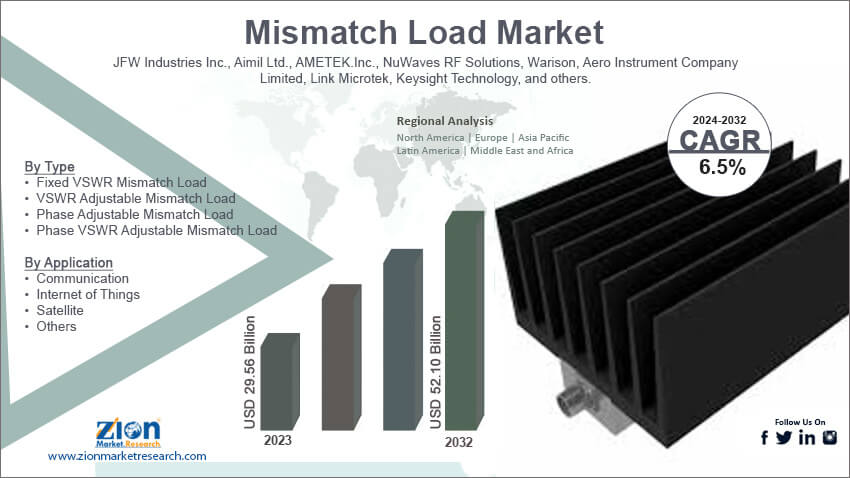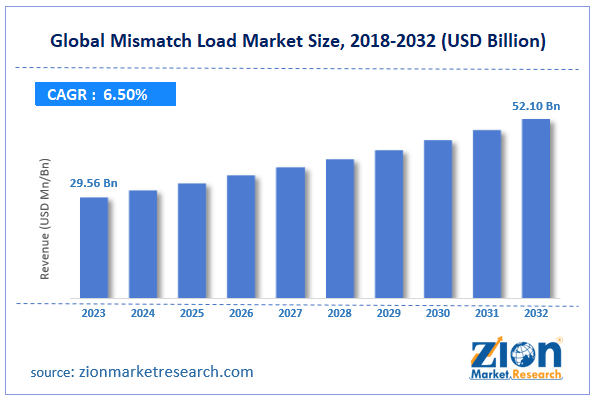Mismatch Load Market Size, Share, Trends, Growth and Forecast 2032

Mismatch Load Market By Type (Fixed VSWR Mismatch Load, VSWR Adjustable Mismatch Load, Phase Adjustable Mismatch Load, and Phase VSWR Adjustable Mismatch Load), By Application (Communication, Internet of Things, Satellite, and Others), and By Region - Global and Regional Industry Overview, Market Intelligence, Comprehensive Analysis, Historical Data, and Forecasts 2024 - 2032
| Market Size in 2023 | Market Forecast in 2032 | CAGR (in %) | Base Year |
|---|---|---|---|
| USD 29.56 Billion | USD 52.10 Billion | 6.5% | 2023 |
Mismatch Load Industry Prospective:
The global mismatch load market size was worth around USD 29.56 billion in 2023 and is predicted to grow to around USD 52.10 billion by 2032 with a compound annual growth rate (CAGR) of roughly 6.5% between 2024 and 2032.
Mismatch Load Market: Overview
A deliberate mismatch in the system impedance to produce RF signal reflections is called a mismatch load. This is frequently done in amplifier test sets to assess the devices' capacity to manage particular reflected power levels. When an RF source's output impedance differs from the load's, the result is a mismatched load. The Voltage Standing Wave Ratio (VSWR) can be used to characterize the amount of the mismatch. By passing signals at different frequencies through the cable to the 50-ohm load that is being tested and seeing what signals are reflected, the VSWR may be found. The mismatch load market is being driven by several factors, such as increasing demand for efficient power systems, growth of renewable energy sources, advancements in data networks & telecommunications, rising focus on system reliability & longevity, smart grid development, and many others.
Key Insights
- As per the analysis shared by our research analyst, the global mismatch load market is estimated to grow annually at a CAGR of around 6.5% over the forecast period (2024-2032).
- In terms of revenue, the global mismatch load market size was valued at around USD 29.56 billion in 2023 and is projected to reach USD 52.10 billion by 2032.
- The growing adoption of IoT in residential and industrial settings is expected to drive the mismatch load sector growth over the forecast period.
- Based on the type, the VSWR Adjustable Mismatch Load segment is expected to grow at the highest CAGR over the forecast period.
- Based on the application, the Internet of Things segment is expected to capture a significant market share over the projected period.
- Based on region, the Asia Pacific is expected to dominate the market during the forecast period.
 Request Free Sample
Request Free Sample
Mismatch Load Market: Growth Drivers
Expansion of the renewable energy sector drives market growth
Due to their unpredictable nature, mismatch load problems frequently result from the integration of renewable energy sources, such as solar and wind, into the power system. Because of this, there is a growing need for solutions to resolve these mismatches, such as power management systems, grid-tied energy storage, and sophisticated inverters. For instance, the International Energy Agency report states that the world has a real chance of meeting the goal set by governments at the COP28 climate change conference last month of tripling global capacity by 2030 because the capacity to generate electricity from renewable sources is growing faster than it has in the last three decades. In 2023, the global addition of renewable energy capacity to energy systems increased by 50% to about 510 gigawatts (GW), with solar photovoltaics (PV) accounting for three-quarters of these additions. Thus, the aforementioned stats propel the mismatch load market over the projected period.
Mismatch Load Market: Restraints
High cost and complexity of implementation hinder market growth
Advanced impedance matching devices, load balancing technologies, and power management systems are a few such solutions to mismatch loads that often require a sizable upfront expenditure. High upfront prices may be a deterrent, especially for small and medium-sized businesses (SMEs) who do not have the financial resources to purchase these solutions. Furthermore, mismatch load solution integration might be technically challenging and require training and experience. Some businesses could be discouraged from using these solutions due to their complexity, which can result in increased costs and longer implementation periods, thereby restricting the mismatch load industry expansion.
Mismatch Load Market: Opportunities
Technological advancement offers a lucrative opportunity for market growth
The growth of the mismatch load market can be ascribed to technology developments that have improved client experiences and product quality while streamlining production processes. By utilizing automation, artificial intelligence, and data analytics, businesses may streamline processes, reduce costs, and make data-driven decisions. Furthermore, by fostering innovation, these technologies assist companies in developing new products and services that cater to the always-changing needs of their customers. Companies that want to stay competitive and encourage market expansion must remain current with technology advancements.
Mismatch Load Market: Challenges
Lack of standardization poses a major challenge to market expansion
Adoption of the mismatch load may be hampered by the absence of defined protocols and methods for handling mismatch loads, particularly in emerging economies. Without standardization, it can be difficult to achieve interoperability across various devices and systems, which makes it challenging to put effective solutions in place. Thus, this is expected to pose a major challenge for the mismatch load market during the projected period.
Mismatch Load Market: Segmentation
The global mismatch load industry is segmented based on type, application, and region.
Based on the type, the global mismatch load market is bifurcated into Fixed VSWR Mismatch Load, VSWR Adjustable Mismatch Load, Phase Adjustable Mismatch Load, and Phase VSWR Adjustable Mismatch Load. The VSWR Adjustable Mismatch Load segment is expected to grow at the highest CAGR over the forecast period. The need for VSWR adjustable mismatch loads is driven by the growth of wireless communication devices, such as smartphones, IoT devices, and 5G infrastructure, to maintain signal integrity and system performance. Furthermore, the aerospace and defense industries have a greater need for precision testing equipment, such as VSWR adjustable mismatch loads, due to their heavy reliance on RF and microwave systems. The requirement for accurate impedance matching and testing is growing as a result of the electronics industry's ongoing innovation in smaller, more potent devices, which is driving up demand for VSWR adjustable mismatch loads.
Based on the application, the global mismatch load industry is bifurcated into communication, Internet of Things, satellite, and others. The Internet of Things segment is expected to capture a significant market share over the projected period. IoT networks are made up of a huge variety of networked devices, from sophisticated machinery to sensors and actuators. Mismatches may occur frequently as a result of the variety and unpredictability of the stress these devices put on power systems, mechanical systems, and networks. Maintaining the proper operation of IoT systems requires managing these incompatibilities. In addition, real-time data processing and quick response to changing conditions are frequently needed for Internet of Things applications. To avoid system overloads and guarantee steady performance, mismatch load solutions in the Internet of Things networks need to be able to dynamically balance loads and make modifications in real time. Furthermore, the proliferation of connected devices, each with a unique load profile, is being caused by the quick development of smart cities, smart households, and industrial IoT (IIoT). Effectively handling these various demands is what's driving the mismatch load market growth.
Mismatch Load Market: Report Scope
| Report Attributes | Report Details |
|---|---|
| Report Name | Mismatch Load Market |
| Market Size in 2023 | USD 29.56 Billion |
| Market Forecast in 2032 | USD 52.10 Billion |
| Growth Rate | CAGR of 6.5% |
| Number of Pages | 221 |
| Key Companies Covered | JFW Industries Inc., Aimil Ltd., AMETEK.Inc., NuWaves RF Solutions, Warison, Aero Instrument Company Limited, Link Microtek, Keysight Technology, and others. |
| Segments Covered | By Type, By Application, and By Region |
| Regions Covered | North America, Europe, Asia Pacific (APAC), Latin America, Middle East, and Africa (MEA) |
| Base Year | 2023 |
| Historical Year | 2018 to 2022 |
| Forecast Year | 2024 - 2032 |
| Customization Scope | Avail customized purchase options to meet your exact research needs. Request For Customization |
Mismatch Load Market: Regional Analysis
Asia Pacific leads the market over the projected period
The Asia Pacific is expected to lead the global mismatch load market growth during the forecast period. Rapid urbanization and massive infrastructure projects, such as smart cities, power grids, and transportation network development, are occurring throughout the Asia Pacific region. As a result of these advancements, complex systems with a high probability of load mismatches are created, increasing the need for effective load mismatch management solutions. For instance, statistics released by the United Nations Human Settlements Program indicate that one of the defining megatrends in the Asia-Pacific area is still urbanization. Over 2.2 billion people, or 54% of the world's metropolitan population, reside in Asia. Asia's urban population is predicted to increase by 50% by 2050, adding 1.2 billion new residents. Thus, the aforementioned stats are expected to drive the mismatch load market in the region.
Mismatch Load Market: Competitive Analysis
The global mismatch load market is dominated by players like:
- JFW Industries Inc.
- Aimil Ltd.
- AMETEK.Inc.
- NuWaves RF Solutions
- Warison
- Aero Instrument Company Limited
- Link Microtek
- Keysight Technology
The global mismatch load market is segmented as follows:
By Type
- Fixed VSWR Mismatch Load
- VSWR Adjustable Mismatch Load
- Phase Adjustable Mismatch Load
- Phase VSWR Adjustable Mismatch Load
By Application
- Communication
- Internet of Things
- Satellite
- Others
By Region
- North America
- The U.S.
- Canada
- Europe
- France
- The UK
- Spain
- Germany
- Italy
- Rest of Europe
- Asia Pacific
- China
- Japan
- India
- South Korea
- Southeast Asia
- Rest of Asia Pacific
- Latin America
- Brazil
- Mexico
- Rest of Latin America
- Middle East & Africa
- GCC
- South Africa
- Rest of Middle East & Africa
Table Of Content
Methodology
FrequentlyAsked Questions
A deliberate mismatch in the system impedance to produce RF signal reflections is called a mismatch load. This is frequently done in amplifier test sets to assess the devices' capacity to manage particular reflected power levels. When an RF source's output impedance is different from the load's, the result is a mismatched load. The Voltage Standing Wave Ratio (VSWR) can be used to characterize the amount of the mismatch. By passing signals at different frequencies through the cable to the 50-ohm load that is being tested and seeing what signals are reflected, the VSWR may be found.
The mismatch load market is driven by several factors, such as increasing demand for efficient power systems, growth of renewable energy sources, advancements in data networks and telecommunications, rising focus on system reliability and longevity, smart grid development, and many others.
According to the report, the global mismatch load market size was worth around USD 29.56 million in 2023 and is predicted to grow to around USD 52.10 million by 2032.
The global mismatch load market is expected to grow at a CAGR of 6.5% during the forecast period.
The global mismatch load market growth is expected to be driven by the Asia Pacific. It is currently the world’s highest revenue-generating market due to rapid industrialization and urbanization.
The global mismatch load market is dominated by players like JFW Industries, Inc., Aimil Ltd., AMETEK.Inc., NuWaves RF Solutions, Warison, Aero Instrument Company Limited, Link Microtek, and Keysight Technology, among others.
The mismatch load market report covers the geographical market along with a comprehensive competitive landscape analysis. It also includes cash flow analysis, profit ratio analysis, market basket analysis, market attractiveness analysis, sentiment analysis, PESTLE analysis, trend analysis, SWOT analysis, trade area analysis, demand & supply analysis, Porter’s five forces analysis, and value chain analysis.
HappyClients
Zion Market Research
Tel: +1 (302) 444-0166
USA/Canada Toll Free No.+1 (855) 465-4651
3rd Floor,
Mrunal Paradise, Opp Maharaja Hotel,
Pimple Gurav, Pune 411061,
Maharashtra, India
Phone No +91 7768 006 007, +91 7768 006 008
US OFFICE NO +1 (302) 444-0166
US/CAN TOLL FREE +1 (855) 465-4651
Email: sales@zionmarketresearch.com
We have secured system to process your transaction.
Our support available to help you 24 hours a day, five days a week.
Monday - Friday: 9AM - 6PM
Saturday - Sunday: Closed






